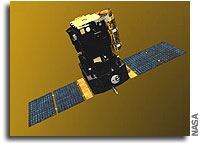SOHO Status Report – February 2004

Mission Status
The spacecraft status is nominal, with the High Gain Antenna (HGA)
Z-axis in a fixed position.
With the HGA Z-axis parked, SOHO continues to experience "keyhole"
periods every three months. Manoeuvres (including a 180? roll) are
now executed during keyholes. With station keeping manoeuvres every
three months, the burns are very small. The last two manoeuvres were
held on 7 October (?V of 0.14 ms-1) and 30 December (?V of
0.075 ms-1).
On 2 September a test showed that the 26m DSN stations can acquire low
rate telemetry through the Low Gain Antenna (LGA) by tweaking the
receiver parameters. SOHO no longer relies on 34m stations for recovery
from, for example, Emergency Sun Reacquisition mode.
The big proton event on 28 October was uneventful for the platform. The
star tracker experienced only a single star swap. The solar arrays
degraded by 1.2%.
Operations and Archiving
All instruments are nominal and SOHO science operations are progressing
smoothly.
The winter keyhole saw significant data losses due to competition for
34m and 70m ground stations from the Mars missions and Stardust. VIRGO
calibrations were secured by carefully planned use of the on-board
recording capacity. Some MDI magnetograms were secured by diverting them
to the medium rate telemetry. Keyhole operations went very smooth.
Links to the SOHO archives (including mirrors) are accessible at
http://soho.estec.esa.nl/data/
Science Highlights
Over two weeks in October/November, the Sun featured three unusually
large sunspot groups (including the largest one of this solar cycle), 11
X-class flares (including the strongest ever recorded), numerous halo
coronal mass ejections (two with near-record speeds) and two significant
proton storms. Satellites, power grids, radio communication and
navigation systems were significantly affected. The events, among the
best observed ever, with data from multiple spacecraft and ground based
observatories, will be the subject of analysis for years to come.
The events caused unprecedented attention from the media and the public.
Images from SOHO and quotes from SOHO scientists appeared in nearly
every major news outlet. The attention wiped out all existing SOHO web
traffic records (requests/data volume): Monthly (31 million/4.3 TB),
weekly (16 million/2.6 TB), daily (4.8 million/0.7 TB), and hourly (0.4
million/33 GB). The daily and hourly volumes were bandwidth limited.
The analysis of high-resolution spectroscopic observations of comet
C/2002 X5 (Kudo-Fujikawa) from UVCS has revealed a quasi-spherical cloud
of neutral hydrogen and a variable tail of ionized carbon (C+ and C2+)
that disconnected from the comet and subsequently regenerated. The high
abundance of C2+ and C+ relative to water (24%) found is unexplainable
by photodissociation of carbon monoxide but instead attributed to the
evaporation and subsequent photoionization of atomic carbon from organic
refractory compounds present in the cometary dust grains.
The 13th SOHO Workshop, "Waves, oscillations and small-scale transient
events in the solar atmosphere: A joint view of SOHO and TRACE" was held
at Palma de Mallorca, Balearic Islands, Spain, on 29 September – 2
October 2003. Nearly 100 participants presented and discussed over 110
papers and posters. The proceedings will be published by ESA (SP-547).








